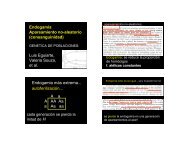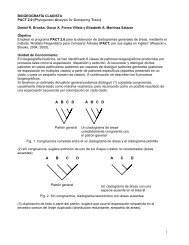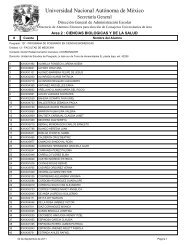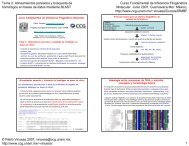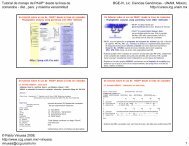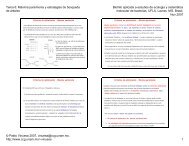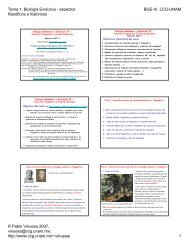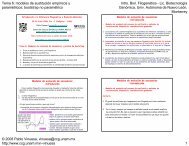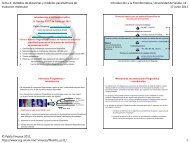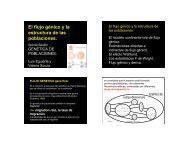Chromosome Structure
Chromosome Structure
Chromosome Structure
Create successful ePaper yourself
Turn your PDF publications into a flip-book with our unique Google optimized e-Paper software.
<strong>Chromosome</strong> <strong>Structure</strong>nitrogen source. One key to efficient growth is control ofgene expression at the level ofRNA transcription. Theprocess ofmaking ofan RNA complement to a DNA geneis called transcription.To accommodate complex regulatory scenarios, chromosomesare divided into discrete transcriptional modulescalled operons. An operon has two functional components:the operator (or control region) and the coding sequence,which encodes the protein or RNA product. Althoughearly studies focused on operons such as lac, trp and his,which produce several proteins from a single operator,73% ofthe 2600 different E. coli operons encode only oneprotein. The operator includes at least one binding site forRNA polymerase, which is the enzyme that makes acomplementary RNA copy ofDNA. RNA polymerase hasa core subunit, plus a specificity factor called sigma (s).Sigma factors direct RNA polymerase to bind a specificsubset ofpromoters. In E. coli there are four sigma factors:s 70 , which controls many housekeeping genes and mostintermediary metabolism operons; s E , which is specific fornitrogen fixation genes; s S , which controls genes that areturned on in stationary phase; and fliA, which is specific forflagellar genes.In addition to RNA polymerase, promoters containboth positive and negative regulatory proteins. Negativeregulatory proteins are called repressors, and they blocktranscription by either impeding access ofRNA polymeraseor by inhibiting its ability to initiate RNA chains. TheLacI repressor blocks expression ofthe lactose genes whenno lactose is available for metabolism. There are alsopositively acting proteins called activators, which stimulateRNA polymerase transcription, either by stabilizing itsbinding to a promoter or by stimulating the ability ofRNApolymerase to initiate RNA chains. One example ofa wellcharacterizedactivator protein is the cyclic adenosinemonophosphate (cAMP)-binding protein (CAP), whichbinds to a large number ofoperator sites and stimulatestranscription when cAMP levels are high.In bacteria, replication and transcription can occursimultaneously. Replication requires all attached, doublestrand-specific DNA-binding proteins to be temporarilydisplaced during complementary strand unwinding andsynthesis. The proteins that have to be removed include thechromosome-associated proteins (see section on Chromatinabove), all repressors and operon activator proteins,and the RNA polymerase. Transcription presents a specialproblem for the replisome. Because transcription andreplication occur simultaneously, two situations arisewhere transcription machinery and replication machinerycollide. One case is where transcription and replicationmove in the same direction. Because a replisome pulls inDNA at 500 bp per second and RNA polymerasetranscribes DNA at 50 bp per second, replication forksrapidly overtake RNA polymerase, even when bothenzymes are headed in the same direction. The morestriking encounter occurs when DNA replication meets atranscribing RNA polymerase molecule moving oppositeto the direction ofreplication fork movement. In bothcases, the replisomes can pass RNA polymerases withoutcausing them to release transcripts or dissociate fromDNA. However, most highly transcribed genes aretranscribed in the same direction as replication forksmove. This includes all seven ofthe ribosomal RNAoperons (black arrowheads in Figure 2b) and 53 ofthe 86transfer RNA genes.In eukaryotic chromosomes, the RNA polymeraseresponsible for transcribing most genes is remarkablysimilar at the structural level to the E. coli RNApolymerase. However, regulatory mechanisms are different.Eukaryotic genes have a region called the promoterwhich is where RNA polymerase binds and startstranscription. However, polymerase binding and its abilityto initiate transcription is influenced by sites calledtranscription enhancers that can be upstream or downstreamofthe promoter (relative to the direction oftranscription). Enhancers act over very large distances,and so DNA looping is required to bring enhancers intocontact with RNA polymerase at promoters. In addition toenhancers, there are proteins called co-activators that mustbind to RNA polymerase to stimulate transcription. Whilethere are many questions about how co-activators work,one important known function is to modify histones byacetylating the H3 and H4 subunits.Recombination<strong>Chromosome</strong>s undergo three types ofgenetic recombination:homologous recombination, site-specific recombinationand transposition. Homologous recombinationinvolves exchanges between regions ofidentical or nearlyidentical sequences that are 300 bp or longer, with theefficiency ofrecombination increasing up to several kbp.Several repetitive sequences, including the seven copies ofthe ribosomal RNA operon in the E. coli genome, are largeenough to stimulate efficient recombination (Figure 2b). InE. coli, the pathway ofhomologous recombination iscarried out and regulated by four genes: recA, recB, recCand recD. Homologous recombination is responsible forthe introduction ofnew information into the bacterialgenome through mechanisms oftransformation, conjugationand transduction. However, another importantfunction of recombination is DNA repair. Recombinationallows replication forks that have stalled or fallen apart torestart DNA synthesis, in addition to allowing onedamaged chromosome to be repaired using informationfrom a sister chromosome. Thus, in addition to being anagent ofchange, recombination helps chromosomesremain the same.Homologous recombination is critical for repair ofDNA damage caused by chemical modification by8 ENCYCLOPEDIA OF LIFE SCIENCES / & 2001 Macmillan Publishers Ltd, Nature Publishing Group / www.els.net



